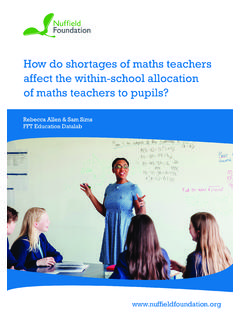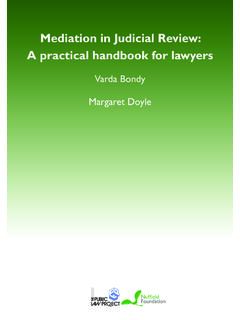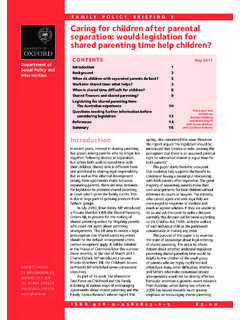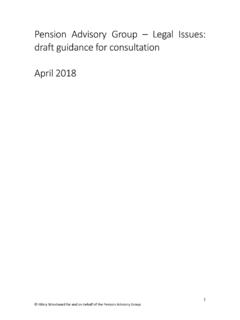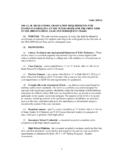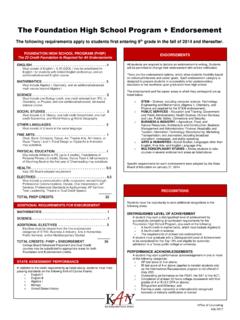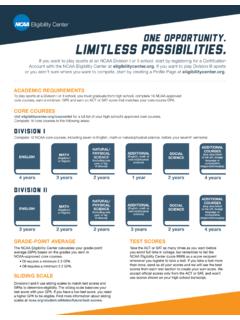Transcription of Key understandings in mathematics learning
1 Key understandings inmathematics learningA review commissioned by the Nuffield Foundation6 Paper 6: Algebraic reasoningBy Anne Watson, University of Oxford 2 SUMMARY PAPER 2: Understanding whole numbers2 Paper 6: Algebraic reasoningIn 2007, the Nuffield Foundation commissioned ateam from the University of Oxford to review theavailable research literature on how children learnmathematics. The resulting review is presented in aseries of eight papers:Paper 1: OverviewPaper 2: Understanding extensive quantities andwhole numbersPaper 3: Understanding rational numbers andintensive quantitiesPaper 4: Understanding relations and their graphicalrepresentationPaper 5: Understanding space and its representationin mathematicsPaper 6: Algebraic reasoningPaper 7: Modelling, problem-solving and integratingconceptsPaper 8: Methodological appendixPapers 2 to 5 focus mainly on mathematics relevantto primary schools (pupils to age 11 years), whilepapers 6 and 7 consider aspects of mathematics in secondary 1 includes a summary of the review, which has been published separately as Introduction andsummary of of papers 1-7 have been publishedtogether as Summary publications are available to download from our website, of Paper 63 Algebraic reasoning8 References 37 About the authorAnne Watson is Professor of MathematicsEducation at the University of the Nuffield FoundationThe Nuffield Foundation is an endowedcharitable trust established in 1943 by WilliamMorris (Lord Nuffield), the founder of MorrisMotors, with the aim of advancing social wellbeing.
2 We fund research and practicalexperiment and the development of capacity to undertake them; working across education,science, social science and social policy. Whilemost of the Foundation s expenditure is onresponsive grant programmes we also undertake our own this review 3 Key understandings in mathematics learningHeadlines algebra is the way we express generalisationsabout numbers, quantities, relations and this reason, good understanding of connectionsbetween numbers, quantities and relations isrelated to success in using algebra . In particular,students need to understand that addition andsubtraction are inverses, and so are multiplicationand division. To understand algebraic symbolisation, studentshave to (a) understand the underlying operationsand (b) become fluent with the notational two kinds of learning , the meaning and thesymbol, seem to be most successful when studentsknow what is being expressed and have time tobecome fluent at using the notation.
3 Students have to learn to recognise the differentnature and roles of letters as: unknowns, variables,constants and parameters, and also the meanings of equality and equivalence. These meanings are not always distinct in algebra and do not relateunambiguously to arithmetical understandings ,Mapping symbols to meanings is not learnt in one-off experiences. Students often get confused, misapply, ormisremember rules for transforming expressionsand solving equations. They often try to applyarithmetical meanings to algebraic expressionsinappropriately. This is associated with over-emphasis on notational manipulation, or on generalised arithmetic , in which they may try to get concise symbolisationThe conventional symbol system is not merely anexpression of generalised arithmetic; to understand it students have to understand the meanings ofarithmetical operations, rather than just be able tocarry them out.
4 Students have to understand inverse and know that addition and subtraction are inverses,and that division is the inverse of representations of relations betweenquantities, such as difference and ratio, encapsulate this idea of inverse. Using familiarity with symbolicexpressions of these connections, rather than thinkingin terms of generalising four arithmetical operations,gives students tools with which to understandcommutativity and distributivity, methods of solvingequations, and manipulations such as simplifying andexpanding expressions. The precise use of notation has to be learnt as well,of course, and many aspects of algebraic notationare inherently confusing ( 2rand r2). Over-reliance on substitution as a method of doing thiscan lead students to get stuck with arithmeticalmeanings and rules, rather than being able torecognise algebraic structures.
5 For example, studentswho have been taught to see expressions such as:97 49 + 49as structures based on relationships betweennumbers, avoiding calculation, identifying variation, andhaving a sense of limits of variability, are able to reasonwith relationships more securely and at a younger agethan those who have focused only on calculation. Anexpression such as 3x+ 4 is both the answer to aquestion, an object in itself, and also an algorithm orprocess for calculating a particular value. This hasparallels in arithmetic: the answer to 3 5 is 3/5. Summary of paper 6: Algebraic reasoning4 SUMMARY PAPER 2: Understanding whole numbersTime spent relating algebraic expressions toarithmetical structures, as opposed to calculations,can make a difference to students is especially important when understanding thatapparently different expressions can be equivalent,and that the processes of manipulation (often themain focus of algebra lessons) are actuallytransformations between equivalent of letters and signsLarge studies of students interpretation and use ofletters have shown a well-defined set of possibleactions.
6 Learners may, according to the task andcontext: try to evaluate them using irrelevant information ignore them used as shorthand for objects, a = apple treat them as objects use a letter as a specific unknown use a letter as a generalised number use a letter as a have to understand that students may useany one of these approaches and students need tolearn when these are appropriate or are conventions and uses of lettersthroughout mathematics that have to be understoodin context, and the statement letters stand fornumbers is too simplistic and can lead to example: it is not always true that different letters havedifferent values a letter can have different values in the sameproblem if it stands for a variable the same letter does not have to have the samevalue in different critical shift is from seeing a letter as representingan unknown, or hidden , number defined within anumber sentence such as:3 + x= 8to seeing it as a variable, as in y = 3+ x, or 3 =y xas some kind of generalizednumber which can take a range of values is seen bysome researchers to provide a bridge from the ideaof unknown to that of variables.
7 The use of boxes to indicate unknown numbers in simple missingnumber statements is sometimes helpful, but canalso lead to confusion when used for variables, or for more than one hidden number in a linked by the equals sign might be not just numerically equal, but also equivalent, yetstudents need to retain the unknown concept whensetting up and solving equations which have finitesolutions. For example, 10x 5 = 5(2x 1) is astatement about equivalence, and xis a variable, but10x 5 = 2x + 1 defines a value of the variable forwhich this equality is true. Thus xin the second casecan be seen as an unknown to be found, but in thefirst case is a variable. Use of graphical software canshow the difference visually and powerfully becausethe first situation is represented by one line, and thesecond by two intersecting lines, one of rulesStudents who rely only on remembered rules oftenmisapply them, or misremember them, or do notthink about the meaning of the situations in whichthey might be successfully applied.
8 Many studentswill use guess-and-check as a first resort whensolving equations, particularly when numbers aresmall enough to reason about hidden numbers instead of undoing within the algebraic this is sometimes a successful strategy,particularly when used in conjunction with graphs,or reasoning about spatial structures, or practicalsituations, over-reliance can obstruct thedevelopment of algebraic understanding and more universally applicable studies of school children showthat, despite being taught the BIDMAS rule and itsequivalents, most do not know how to decide onthe order of operations represented in an algebraicexpression. Some researchers believe this to be dueto not fully understanding the underlying operations,others that it may be due to misinterpretation ofexpressions. There is evidence from Australia andthe United Kingdom that students who are taughtto use flow diagrams, and inverse flow diagrams, toconstruct and reorganise expressions are betterable to decide on the order implied by expressionsinvolving combinations of operations.
9 However, it isnot known whether students taught this way cansuccessfully apply their knowledge of order insituations in which flow diagrams are inappropriate,such as with polynomial equations, those involvingthe unknown on both sides , and those with morethan one variable. To use algebra effectively,decisions about order have to be fluent and 6: Algebraic reasoningMisapplying arithmeticalmeanings to algebraicexpressionsAnalysis of children s algebra in clinical studies with12- to 13-year-olds found that the main problems inmoving from arithmetic to algebra arose because: the focus of algebra is on relations rather thancalculations; the relation a + b=crepresents threeunknown quantities in an additive relationship students have to understand inverses as well asoperations, so that a hidden value can be foundeven if the answer is not obvious from knowingnumber bonds or multiplication facts; 7 + b= 4 canbe solved using knowledge of addition, but c+ 63= 197 is more easily solved if subtraction is used asthe inverse of addition some situations have to be expressed algebraicallyfirst in order to solve them.
10 My brother is twoyears older than me, my sister is five years youngerthan me; she is 12, how old will my brother be inthree years time? requires an analysis andrepresentation of the relationships before solution. algebra in this situation means constructing amethod for keeping track of the unknown asvarious operations act upon it. letters and numbers are used together, so thatnumbers may have to be treated as symbols in astructure, and not evaluated. For example, thestructure 2(3+b) is different from the structure of 6+2balthough they are equivalent in computationalterms. Learners have to understand that sometimesit is best to leave number as an element in analgebraic structure rather than work it out . the equals sign has an expanded meaning; inarithmetic it is often taken to mean calculate but inalgebra it usually means is equal to or is equivalentto.
